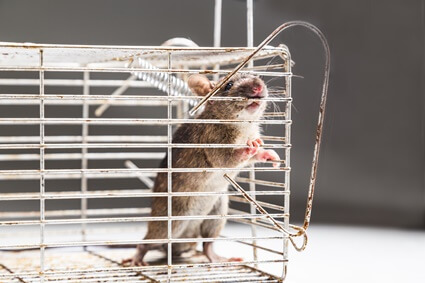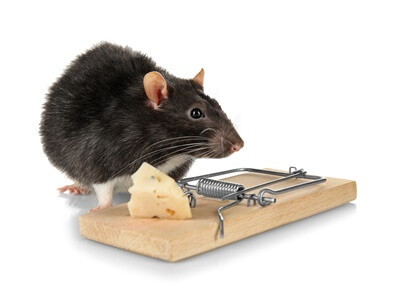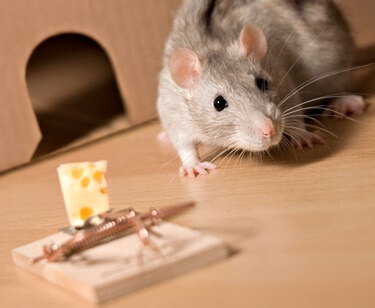It can be frustrating to discover that the traps you’ve laid out to capture the rats aren’t working.
Rats can learn to avoid traps over time by having good memories and recalling past events. Not only that, but their brains can form neural connections with objects in their environment.
When a rat survives getting caught in a trap or sees another rat in the same situation, it’ll recall the experience when it encounters a similar trap in the future.
Set traps along the paths that rats take and provide enticing bait, such as cheese or bacon. You can lay unarmed traps around your home for several days and arm them to trick the rats into feeling safe.
Do Rats Know When There is a Trap?
Rats have neophobia (fear of something new), so they’re suspicious of new objects in their environment.
Usually, rats follow the same path to and from their nests when foraging for food and other supplies. So, they react cautiously when they encounter anything unfamiliar in their path.
So, a trap may be avoided because rats suspect it might pose a threat. Their high intelligence, stealth, and cautiousness make trapping rats a genuine challenge.
Why Won’t Rats Go Near My Traps?
You need to understand the common mistakes of setting rat traps so you can avoid them. These include:

Absence of Baits
Rats have a strong sense of smell due to their high number of olfactory receptors. This allows them to trail the odor of food and follow it to the source. Failing to put food bait in a rat trap means there is no scent to lure rats to the trap.
That said, glue traps don’t require bait if positioned correctly. Nevertheless, you should always endeavor to put bait in your rat traps to entice rats and prevent them from avoiding the traps.
Poor Placement
Many people incorrectly position their traps when trying to catch or kill rats. This leads to dismal results and little success in catching these stealthy rodents.
Rats prefer specific paths when foraging for food. They’ll avoid open spaces and instead crawl in the corners and edges of walls.
Therefore, if you’ve been trying to catch rats using traps without much success, consider changing the location of your traps.
Setting your traps near the wall throws off the rat’s perception and makes them think the trap is part of the wall. This makes them trust the trap and reduces their chances of avoiding it.
New Trap
As mentioned, rats are neophobic by nature. This means they are cautious about engaging with new or unfamiliar objects in their environment.
Setting a new trap might take hours or days before the rats are comfortable enough to approach it.
Holding the Trap With Bare Hands
Rats, including humans, can pick up on the scent of possible threats in their environment.
If you set up a rat trap with your bare hands, rats can detect your lingering scent when they come near it. This raises their threat awareness and prompts them to stay away from the trap.
Furthermore, young rats can develop this way of evading traps when foraging with their much older and experienced counterparts. As such, you should refrain from making direct contact with rat traps.
Poor Bait Choice
The type of bait you select for your trap may also determine whether or not rats avoid your trap.
Rats won’t go near a trap if they don’t find the bait appealing. Therefore, when setting rat traps, you need to pick bait that’s irresistible to rats to entice them.
How to Prevent Rats From Avoiding Traps
It’s a tricky process to stop rats from avoiding traps. It requires patience, time, and knowledge of how the rats in your home operate. Here are some tips:
Locate the Food Source
When attempting to catch rats, locate the food where the rodents are foraging.
Locations that serve as food hotspots for rats include the kitchen and dining area. If you carry food into your bedroom, this may also draw in rats looking for treats.
Bait The Trap
Once you’ve identified where rats are foraging for food, choose good bait and set it on your trap according to the manufacturer’s specifications.
Select a treat that rats find irresistible. The best foods include:
- Cheese.
- Dried fruit.
- Bacon.
- Sausages.
- Peanut butter.
Place your bait strategically, dropping one piece inside the trap and another near it. Also, remember not to touch the trap with your bare hands. Otherwise, you may leave your scent on it, which may cause rats to avoid it.
Regularly Inspect The Trap
Once you set your trap, don’t expect it to catch rats immediately. If you find that no rats have been captured after 2 days, change the positions of the bait, but do not replace or change the trap’s location.
Doing so will make any returning rats suspicious, and they’ll be more cautious about approaching the trap.
Why Is My Rat Bait Missing, But There Is No Rat?
It’s disheartening to find your rat bait missing without any rats captured.
Here are the reasons this happens:
Bait Being Eaten By Other Animals
When you find your bait eaten but no rat has been captured, it is likely that other animals are eating it.
Mice, for instance, can easily step on rat traps and consume the bait without setting them off. Their small body weight may not apply enough pressure to trigger the trap. If this is the case, you should establish mice traps first to get rid of rats before dealing with the rat problem.
Slugs and snails can also consume the bait in your rat traps without setting them off. You can determine this by checking for silvery trails in and around the trigger plate of your rat trap.
Rats’ Stealthy Behavior
Intelligent rats can often get the bait without setting off the trap. To reduce the chances of this happening, use a good amount of bait so that rats struggle to remove it from the trap.
The struggle alone may set off the trap while the rat tries to steal its prize.
Will a Rat Go Back to The Same Trap?
If a rat has survived getting caught by a trap, chances are, it won’t come near that trap again. Rats have good memories of past events and can recall any threats they have experienced.
The British Journal of Animal Behaviour found that this results in bait shyness. Rats are intelligent enough to learn from their mistakes if they encounter poisoned bait or see other rats die from poisoned bait. This can extend to bad experiences with traps as well.
As such, if a rat narrowly misses getting caught in a trap, it’ll learn to avoid it. For this reason, you should replace your traps regularly when attempting to catch several rats in your home.
Rats are suspicious of any new objects in their environment. Don’t expect the new traps to work immediately. It can take time before the rats become familiar enough with the trap to lower their guard.
How to Catch A Smart Rat
Catching a smart rat can be challenging since they have mastered stealthily avoiding traps.
The Journal Of The Experimental Analysis Of Behavior found that intelligent rats free their counterparts if caught in traps. However, this doesn’t mean it can’t be done because intelligent rats are harder to catch than ordinary ones.
Below are strategies you can use to capture a stealthier and more experienced rat:

Study the Rat’s Behavioral Patterns
The first step involves determining the species of rat.
Norway rats prefer to live and move in subterranean areas, such as burrows, sewers, and basements. They’re larger in size and brown in color, with short stubby noses and small ears. These rats are not fussy eaters, meaning they’ll eat anything they can find.
As such, you have various bait choices to work with if you’re attempting to capture this type of rat. According to the New Zealand Journal of Ecology, these rats prefer chocolate and cheese baits.
Roof rats live in above-ground locations such as treetops, roof heaves, ceilings, and attics. They’re much smaller than Norway rats and dark brown or black, with large ears and sharp noses. These rats are picky eaters, preferring to subsist on dried fruits, nuts, and grains.
Understand How Rats Get Into Your Home
The entry point is ideal for setting your trap, even if it means strapping it to a tree or wall. Rats are creatures of habit, which means they prefer using the same paths in their foraging excursions. Therefore, positioning your trap near an entrance point significantly raises your chances of catching the rats.
Likewise, you can seal the entry points to prevent more rats from entering. Don’t worry too much about trapping them inside your house. It’s easier to shut them out from a food source when they can’t get in and out.
Consequently, they will become more desperate to find food and likely take more risks, thus increasing your chances of catching them.
Make The Trap a Familiar Place for the Rats
When dealing with intelligent rats, you must be more innovative if you hope to catch them.
Make your trap feel like a safe place for the rats. To do this, you can keep several unarmed traps with food baits in your home so that they become familiar places for the rats to go and eat.
You are trying to condition the rats not to fear the traps. Once they become comfortable hanging around the traps, you can set up armed ones to catch the rodents. Since they have learned to view armed traps as harmless, they’ll be more likely to approach and step on armed traps.







